Rheological and Mechanical Characterization of Self-Compacting Concrete Using Recycled Aggregate
Abstract
1. Introduction
2. Research Significance
3. Materials and Methods
3.1. Cement
3.2. Ceramic Waste Powder
3.3. Fine and Coarse Aggregates
3.4. Superplasticizer
3.5. Glass
4. Specimens Preparation
5. Testing Method
- (a)
- Slump flow test
- (b) Slump flow time at T50 cm
- (c) J-ring flow
- (d) V-funnel
- (e) V-funnel after 5 min
- (f) L-box test
6. Results and Discussion
6.1. Fresh State Properties
6.1.1. Slump Flow
6.1.2. Slump T500
6.1.3. J-Ring
6.1.4. V-Funnel
6.1.5. V-Funnel After 5 min
6.1.6. L-Box
6.2. Hardened State Properties
6.2.1. Compressive Strength
6.2.2. Flexural Strength
6.2.3. Splitting Tensile Strength
6.3. Relationships Between the Mechanical Strength (Compressive, Flexural, and Tensile)
7. Conclusions
- (1)
- A possible effective solution exists for using CWP and RG in SCC manufacturing, reducing the environmental impact of waste deposition, cement, and concrete manufacturing.
- (2)
- The results revealed good rheological properties that comply with code and guidelines, especially ECP 203.
- (3)
- Partial replacement cement with 15 to 20% CWP and fine aggregate by 5 to 10% RG would enhance the flowability due to their hydrophobic properties.
- (4)
- The passing ability of SCC while utilizing the CWP and RG provides privilege in congested reinforcement members.
- (5)
- Generally, the compressive strength is reduced slightly, which is not critical; however, the flexural strength is enhanced, which is a good achievement.
- (6)
- Compressive, flexural, and tensile strengths were reduced as CWP was replaced by more than 20% cement and over 10% RG as a fine aggregate replacement.
- (7)
- The optimum and best performance was achieved at 15% CWP and 10% RG replacement of cement and fine aggregate, especially in flexural and tensile strengths corresponding to the control mix of SCC.
Author Contributions
Funding
Institutional Review Board Statement
Informed Consent Statement
Data Availability Statement
Acknowledgments
Conflicts of Interest
References
- Jain, A.; Gupta, R.; Chaudhary, S. Performance of self-compacting concrete comprising granite cutting waste as fine aggregate. Constr. Build. Mater. 2019, 221, 539–552. [Google Scholar] [CrossRef]
- Alaloul, W.S.; Musarat, M.A.; ATayeh, B.; Sivalingam, S.; Rosli, M.F.B.; Haruna, S.; Khan, M.I. Mechanical and deformation properties of rubberized engineered cementitious composite (ECC). Case Stud. Constr. Mater. 2020, 13, e00385. [Google Scholar] [CrossRef]
- Gautam, L.; Jain, J.K.; Kalla, P.; Danish, M. Sustainable utilization of granite waste in the production of green construction products: A review. Mater. Today Proc. 2021, 44, 4196–4203. [Google Scholar] [CrossRef]
- Subaşı, S.; Öztürk, H.; Emiroğlu, M. Utilizing waste ceramic powders as filler material in self-consolidating concrete. Constr. Build. Mater. 2017, 149, 567–574. [Google Scholar] [CrossRef]
- Tayeh, B.A.; Al Saffar, D.M.; Aadi, A.S.; Almeshal, I. The sulfate resistance of cement mortar contains glass powder. J. King Saud Univ. Eng. Sci. 2020, 32, 495–500. [Google Scholar] [CrossRef]
- Agrawal, A.; Singh, A.; Imam, A. Utilization of Ceramic Waste as a Sustainable Building Material. In Proceedings of the 2020 National Conference on Structural Engineering NCRASE—2020, Jamshedpur, India, 21–22 August 2020. [Google Scholar]
- Gautam, L.; Jain, J.K.; Kalla, P.; Choudhary, S. A review on the utilization of ceramic waste in sustainable construction products. Mater. Today Proc. 2021, 43, 1884–1891. [Google Scholar] [CrossRef]
- Gautam, L.; Kumar Jain, J.; Alomayri, T.; Meena, N.; Kalla, P. Performance evaluation of self-compacting concrete comprising ceramic waste powder as fine aggregate. Mater. Today Proc. 2022, 61, 204–211. [Google Scholar] [CrossRef]
- El-Dieb, A.S.; Kanaan, D.M. Ceramic waste powder an alternative cement replacement—Characterization and evaluation. Sustain. Mater. Technol. 2018, 17, e00063. [Google Scholar] [CrossRef]
- Aly, S.T.; El-Dieb, A.S.; Taha, M.R. Effect of High-Volume Ceramic Waste Powder as Partial Cement Replacement on Fresh and Compressive Strength of Self-Compacting Concrete. J. Mater. Civ. Eng. 2019, 31, 04018374. [Google Scholar] [CrossRef]
- Li, L.G.; Zhuo, Z.Y.; Zhu, J.; Chen, J.J.; Kwan, A.K.H. Reutilizing ceramic polishing waste as powder filler in mortar to reduce cement content by 33% and increase strength by 85%. Powder Technol. 2019, 355, 119–126. [Google Scholar] [CrossRef]
- Sivaprakash, G.; Saravana, K.V.; Saikia, L.J. Experimental study on partial replacement of sand by ceramic waste in concrete. Int. J. Chem. Sci. 2016, 14, 266–274. [Google Scholar]
- Mohit, M.; Ranjbar, A.; Sharifi, Y. Mechanical and microstructural properties of mortars incorporating ceramic waste powder exposed to the hydrochloric acid solution. Constr. Build. Mater. 2021, 271, 121565. [Google Scholar] [CrossRef]
- Alsaif, A. Utilization of ceramic waste as partially cement substitute—A review. Constr. Build. Mater. 2021, 300, 124009. [Google Scholar] [CrossRef]
- El-Dieb, A.S.; Taha, M.R.; Kanaan, D.; Aly, S.T. Ceramic waste powder: From landfill to sustainable concretes. Proc. Inst. Civ. Eng. Constr. Mater. 2018, 171, 109–116. [Google Scholar] [CrossRef]
- Chen, X.; Zhang, D.; Cheng, S.; Xu, X.; Zhao, C.; Wang, X.; Wu, Q.; Bai, X. Sustainable reuse of ceramic waste powder as a supplementary cementitious material in recycled aggregate concrete: Mechanical properties, durability, and microstructure assessment. J. Build. Eng. 2022, 52, 104418. [Google Scholar] [CrossRef]
- Mohit, M.; Sharifi, Y. Thermal and microstructure properties of cement mortar containing ceramic waste powder as alternative cementitious materials. Constr. Build. Mater. 2019, 223, 643–656. [Google Scholar] [CrossRef]
- Kannan, D.M.; Aboubakr, S.H.; EL-Dieb, A.S.; Reda Taha, M.M. High-performance concrete incorporating ceramic waste powder as a large partial replacement of Portland cement. Constr. Build. Mater. 2017, 144, 35–41. [Google Scholar] [CrossRef]
- Shayan, A.; Xu, A. Performance of glass powder as a pozzolanic material in concrete: A field trial on concrete slabs. Cem. Concr. Res. 2006, 36, 457–468. [Google Scholar] [CrossRef]
- Hamada, H.; Alattar, A.; Tayeh, B.; Yahaya, F.; Thomas, B. Effect of recycled waste glass on the properties of high-performance concrete: A critical review. Case Stud. Constr. Mater. 2022, 17, e01149. [Google Scholar] [CrossRef]
- Sharifi, Y.; Houshiar, M.; Aghebati, B. Recycled glass replacement as fine aggregate in self-compacting concrete. Front. Struct. Civ. Eng. 2013, 7, 419–428. [Google Scholar] [CrossRef]
- Kou, S.C.; Poon, C.S. Properties of self-compacting concrete prepared with recycled glass aggregate. Cem. Concr. Compos. 2009, 31, 107–113. [Google Scholar] [CrossRef]
- Shiva Srikanth, K.; Lalitha, G. Durability properties of self-compacting concrete partial replacement of fine aggregate with waste crushed glass. Mater. Today Proc. 2022, 51, 2411–2416. [Google Scholar] [CrossRef]
- Singh, H.; Siddique, R. Utilization of crushed recycled glass and metakaolin for the development of self-compacting concrete. Constr. Build. Mater. 2022, 348, 128659. [Google Scholar] [CrossRef]
- Ketov, A.; Rudakova, L.; Vaisman, I.; Ketov, I.; Haritonovs, V.; Sahmenko, G. Recycling of rice husks ash for the preparation of resistant, lightweight and environment-friendly fired bricks. Constr. Build. Mater. 2021, 302, 124385. [Google Scholar] [CrossRef]
- Mohamed, H.A. Effect of fly ash and silica fume on compressive strength of self-compacting concrete under different curing conditions. Ain Shams Eng. J. 2011, 2, 79–86. [Google Scholar] [CrossRef]
- El-Nemr, A.; Shaaban, I.G. Assessment of Special Rubberized Concrete Types Utilizing Portable Non-Destructive Tests. NDT 2024, 2, 160–189. [Google Scholar] [CrossRef]
- ASTM C33; Specification for Concrete Aggregates. ASTM International: West Conshohocken, PA, USA, 2011. [CrossRef]
- ECP 203; Egyptian Code of Practice for Reinforced Concrete Design and Construction ECP-203-2020. ECP: Kairo, Egypt, 2020.
- BS 882; Specification for Aggregates from Natural Resources for Concrete. British Standard: London, UK, 1992.
- ASTM C494/C494M; Specification for Chemical Admixtures for Concrete. ASTM International: West Conshohocken, PA, USA, 2019. [CrossRef]
- ASTM C1017/C1017M; Standard Specification for Chemical Admixtures for Use in Producing Flowing Concrete. ASTM International: West Conshohocken, PA, USA, 2013.
- ASTM C1611; Test Method for Slump Flow of Self-Consolidating Concrete. ASTM International: West Conshohocken, PA, USA, 2021. [CrossRef]
- ASTM C1621; Test Method for Passing Ability of Self-Consolidating Concrete by J-Ring. ASTM International: West Conshohocken, PA, USA, 2017. [CrossRef]
- EN 12350-9; Testing Fresh Concrete—Part 9: Self-Compacting Concrete—V-Funnel Test. International Organization for Standardization: Geneva, Switzerland, 2010.
- EN 12350-9; Testing Fresh Concrete—Part 10: Self-Compacting Concrete—L-box Test. International Organization for Standardization: Geneva, Switzerland, 2010.
- Ali, E.E.; Al-Tersawy, S.H. Recycled glass as a partial replacement for fine aggregate in self-compacting concrete. Constr. Build. Mater. 2012, 35, 785–791. [Google Scholar] [CrossRef]
- Jassam, S.H.; Qasim, O.A.; Maula, B.H. Impact of Glass on Concrete Properties as Substitution of Aggregate. Key Eng. Mater. 2022, 929, 155–165. [Google Scholar] [CrossRef]
- Hesami, S.; Salehi Hikouei, I.; Emadi, S.A.A. Mechanical behavior of self-compacting concrete pavements incorporating recycled tire rubber crumb and reinforced with polypropylene fiber. J. Clean. Prod. 2016, 133, 228–234. [Google Scholar] [CrossRef]
- Revilla-Cuesta, V.; Skaf, M.; Faleschini, F.; Manso, J.M.; Ortega-López, V. Self-compacting concrete manufactured with recycled concrete aggregate: An overview. J. Clean. Prod. 2020, 262, 121362. [Google Scholar] [CrossRef]
- Tang, W.C.; Ryan, P.C.; Cui, H.Z.; Liao, W. Properties of Self-Compacting Concrete with Recycled Coarse Aggregate. Adv. Mater. Sci. Eng. 2016, 2016, 2761294. [Google Scholar] [CrossRef]
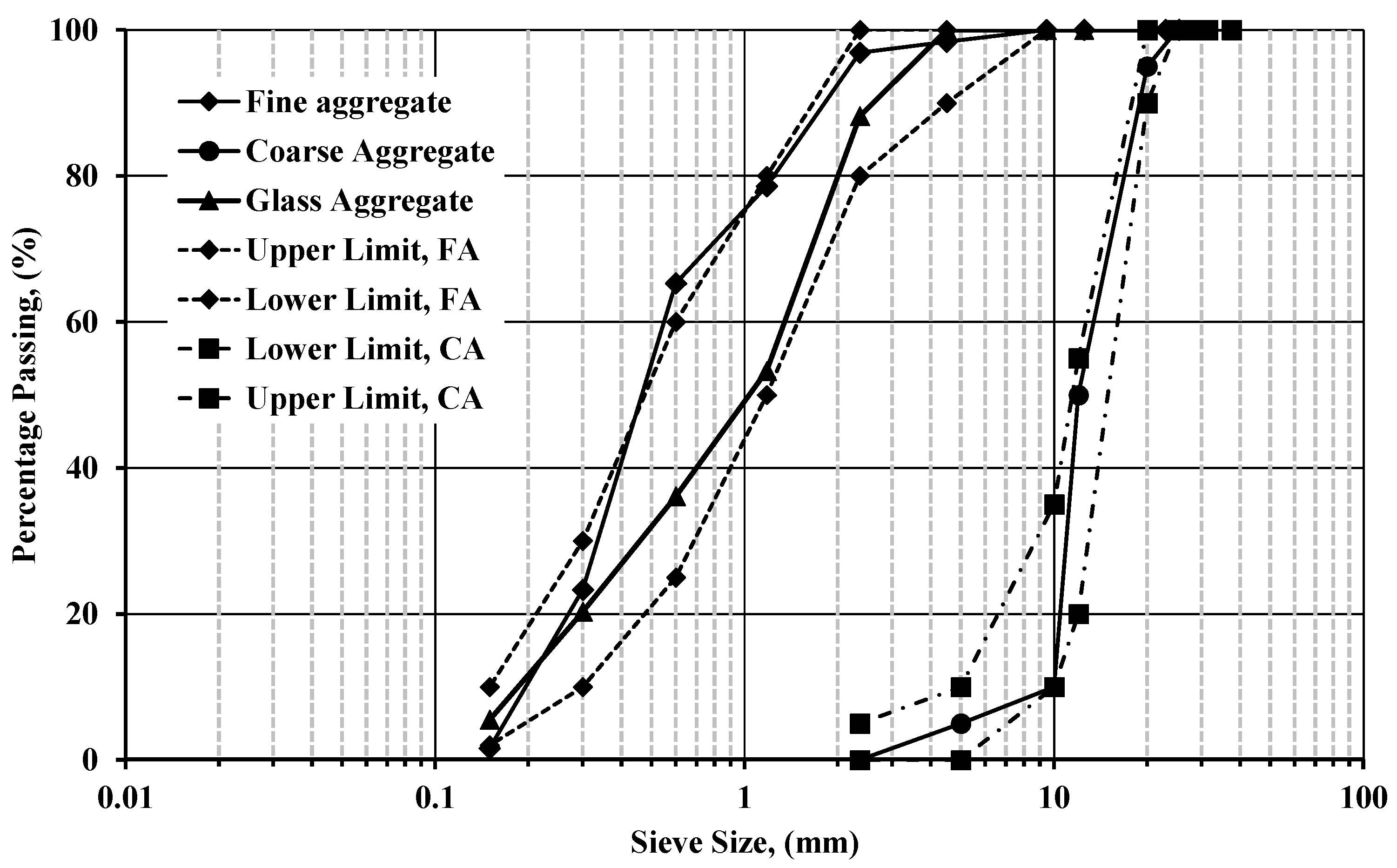
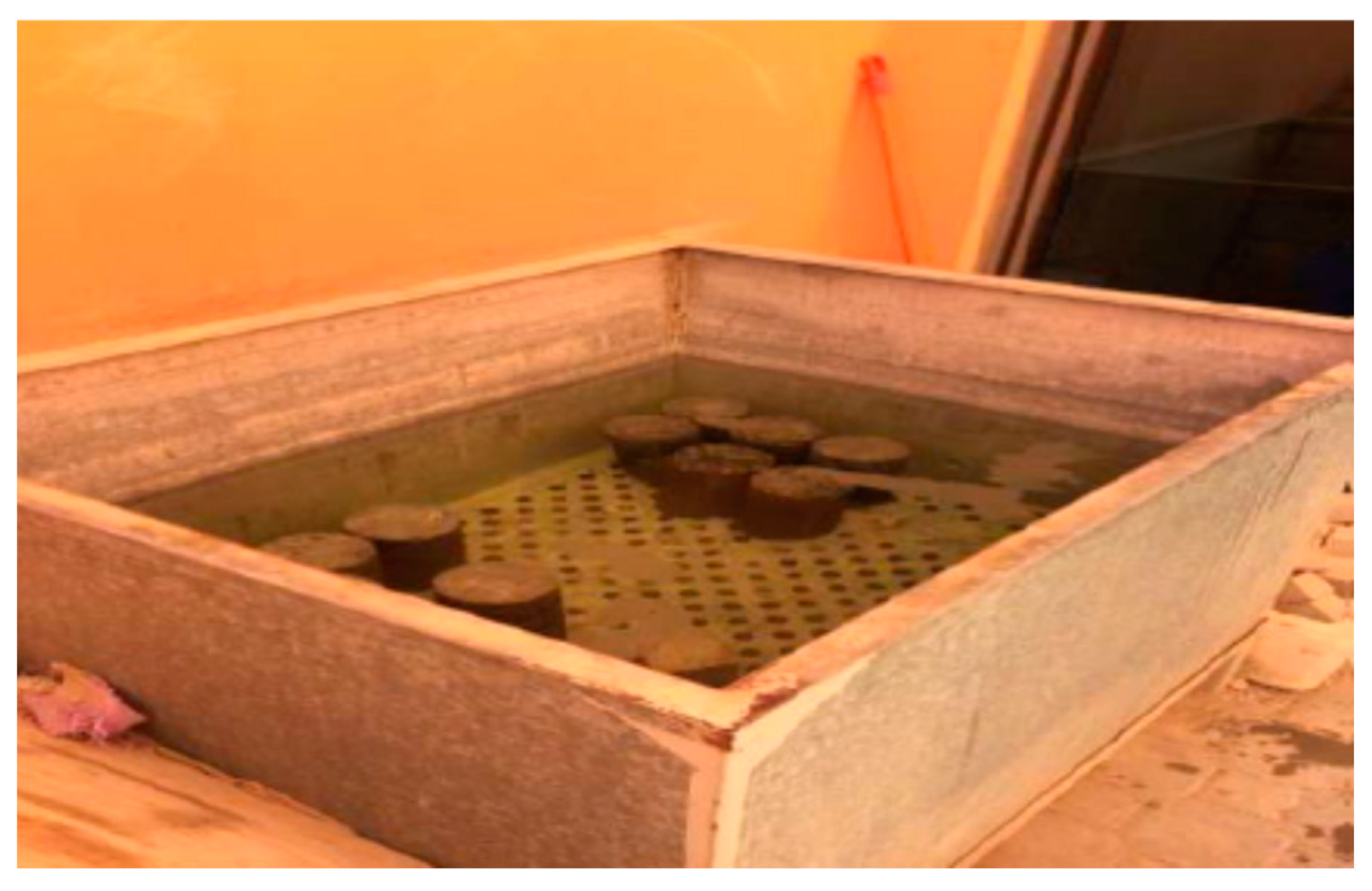
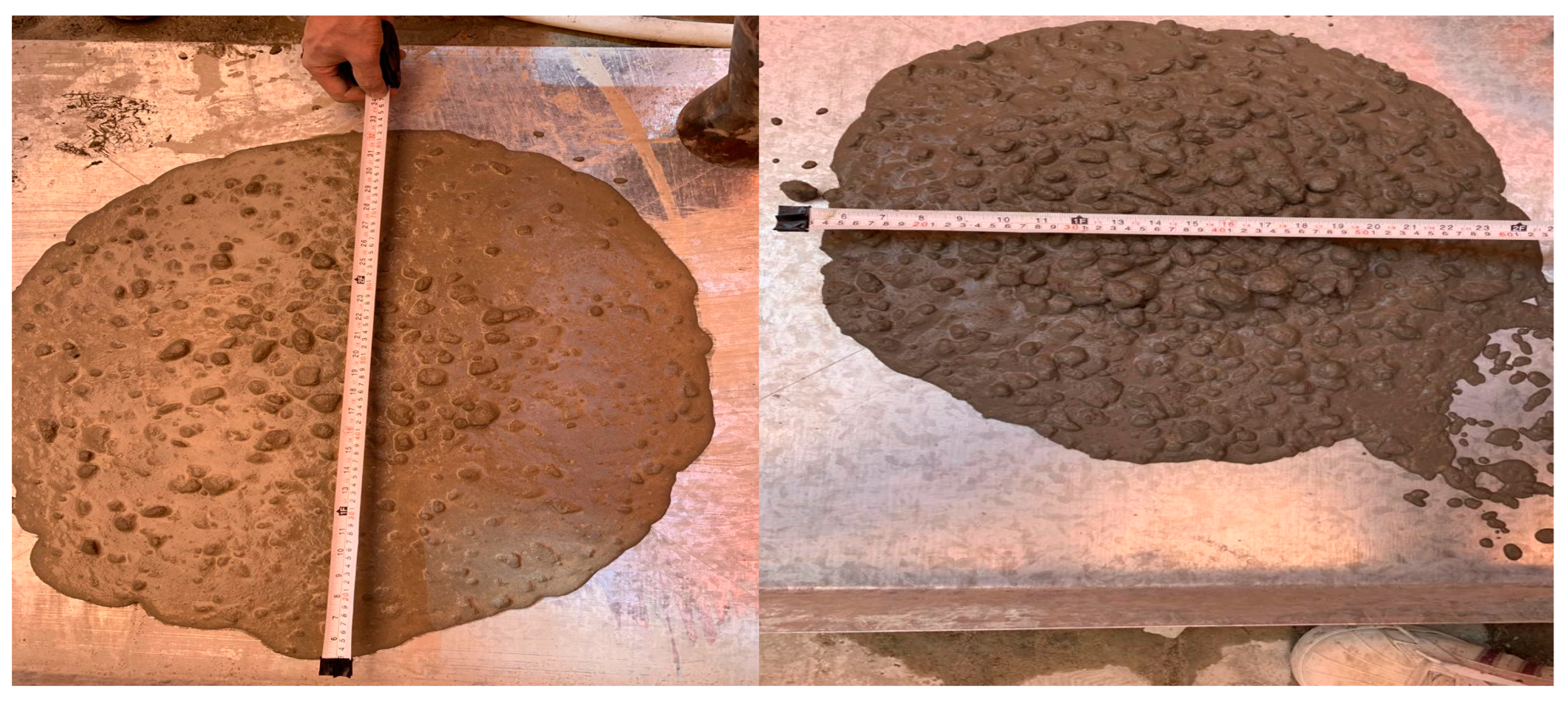
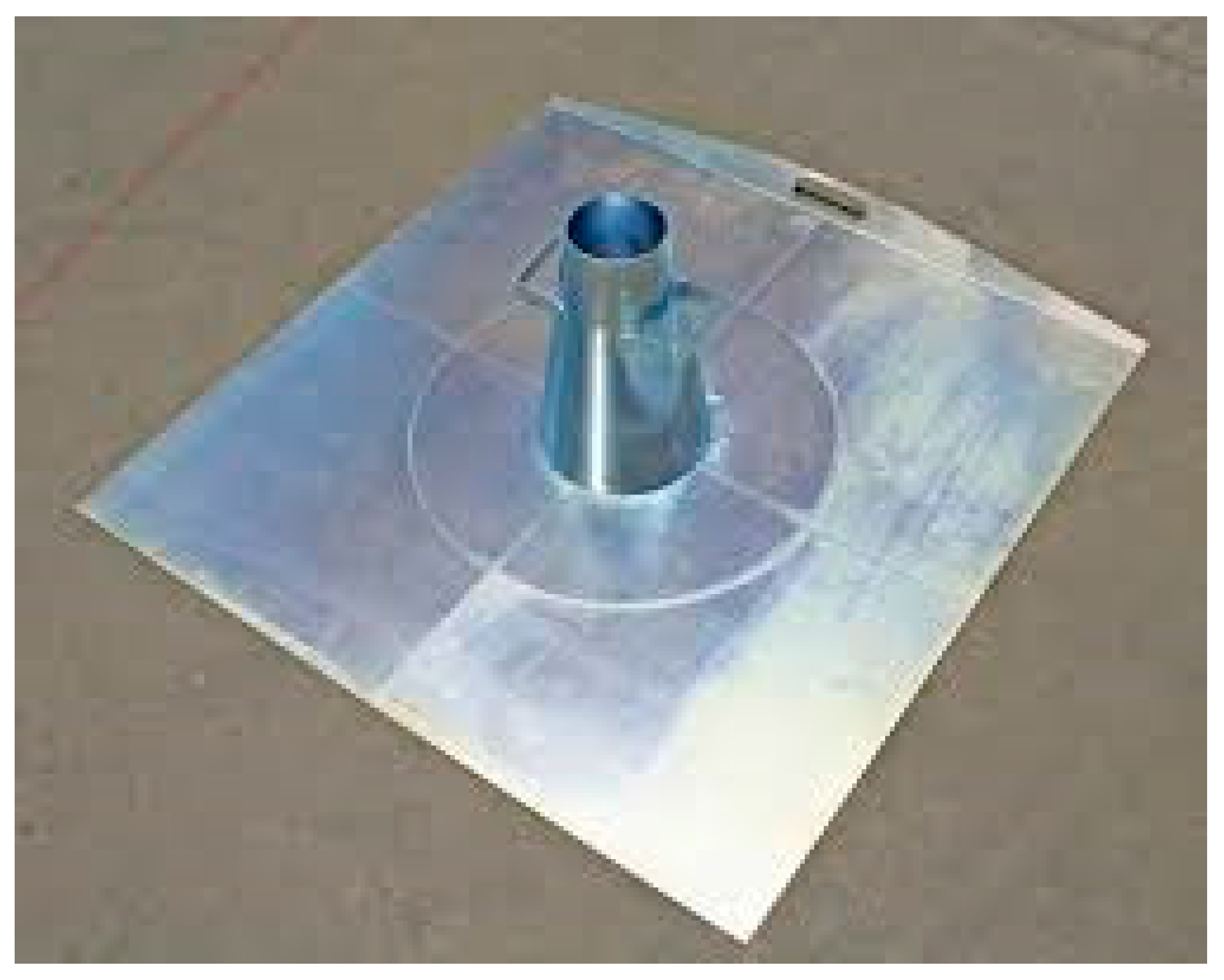
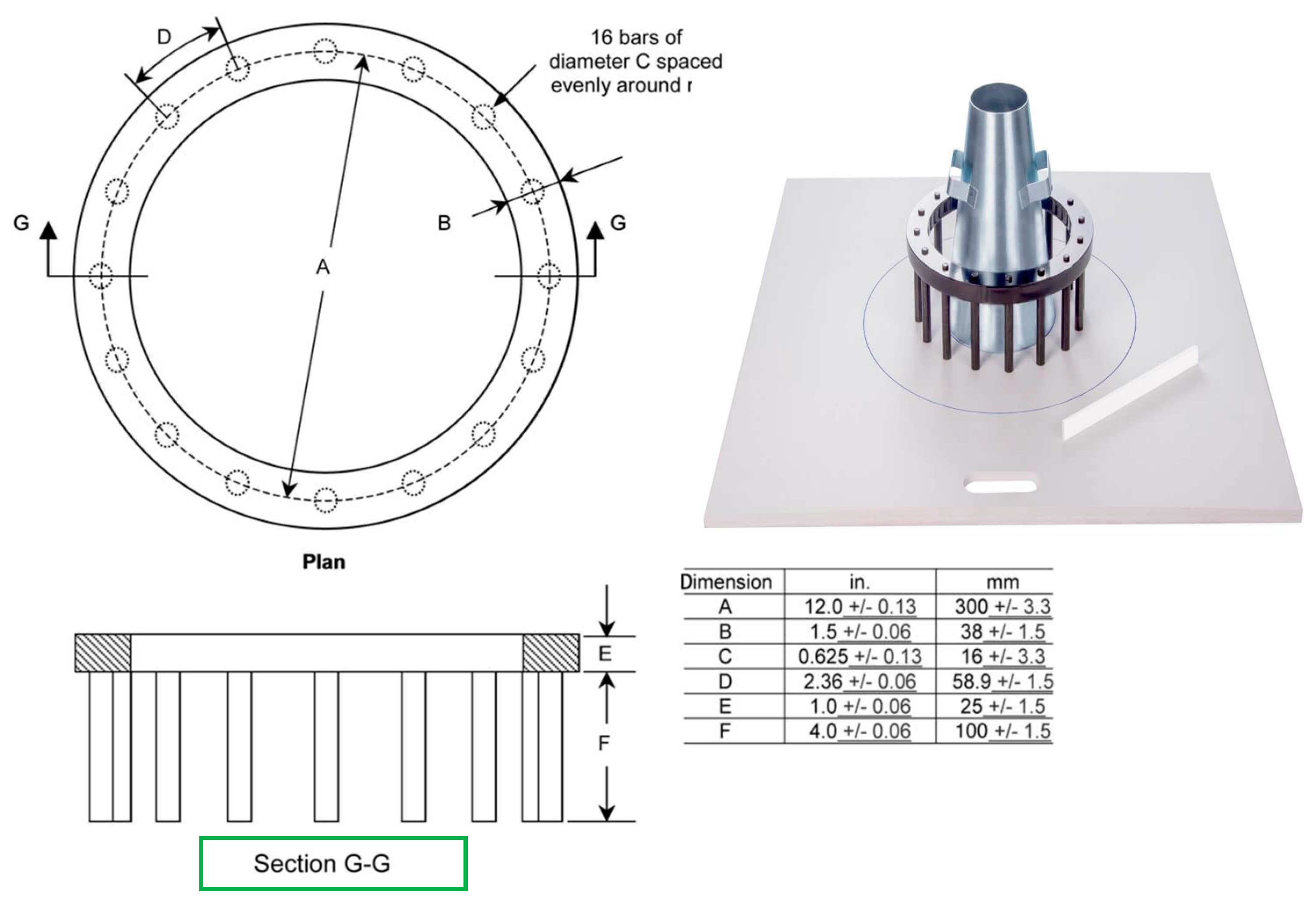



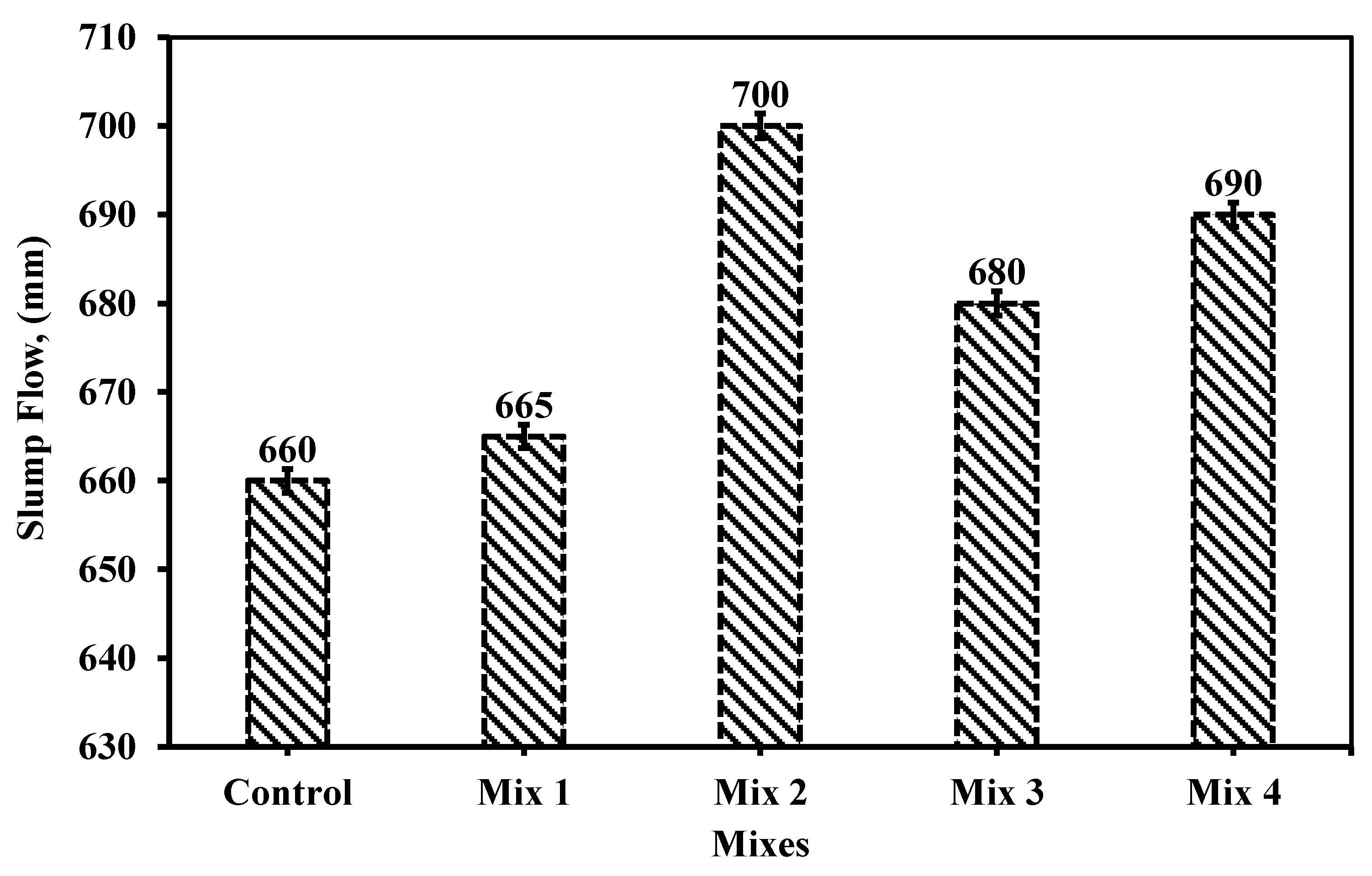
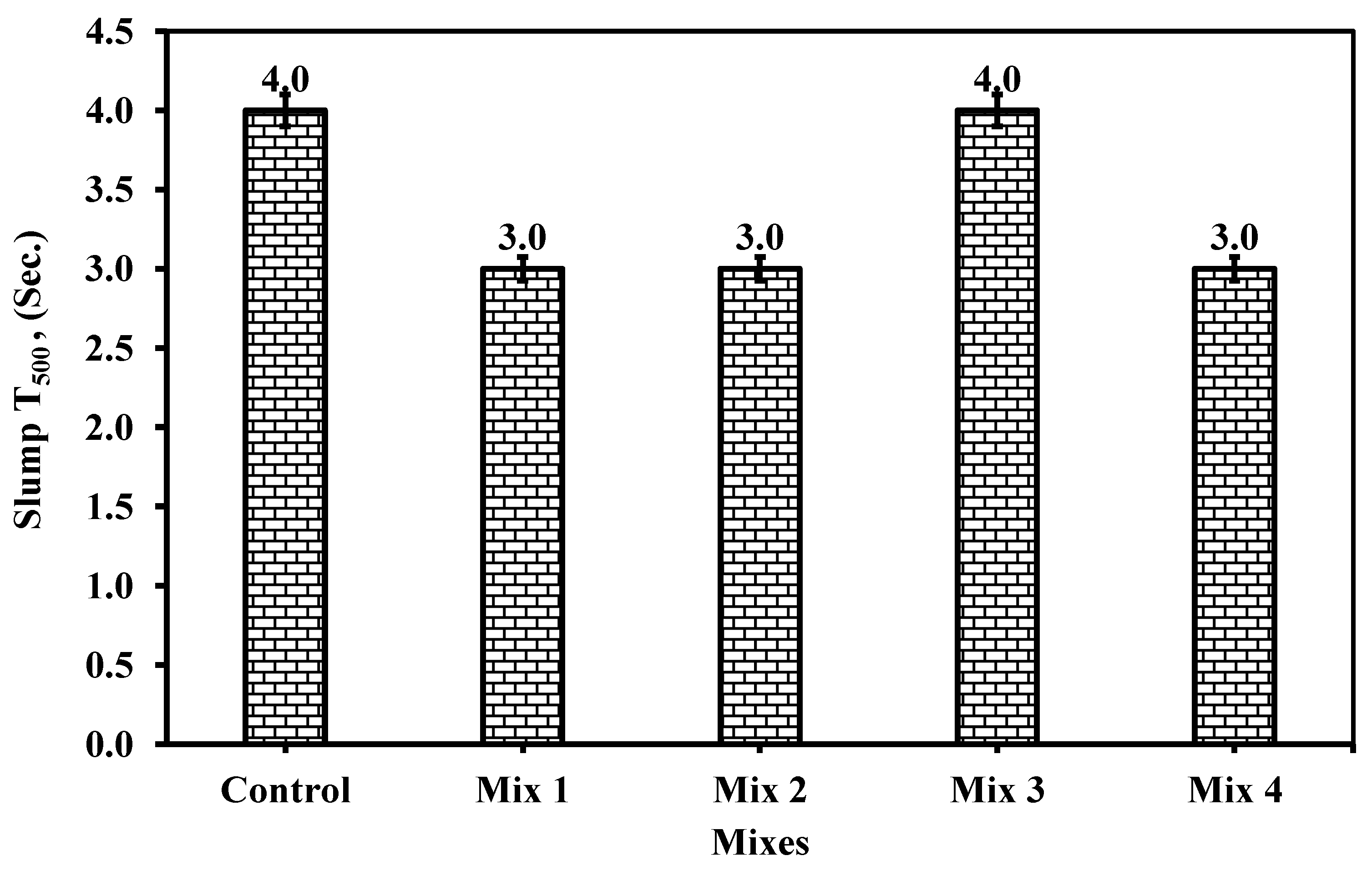
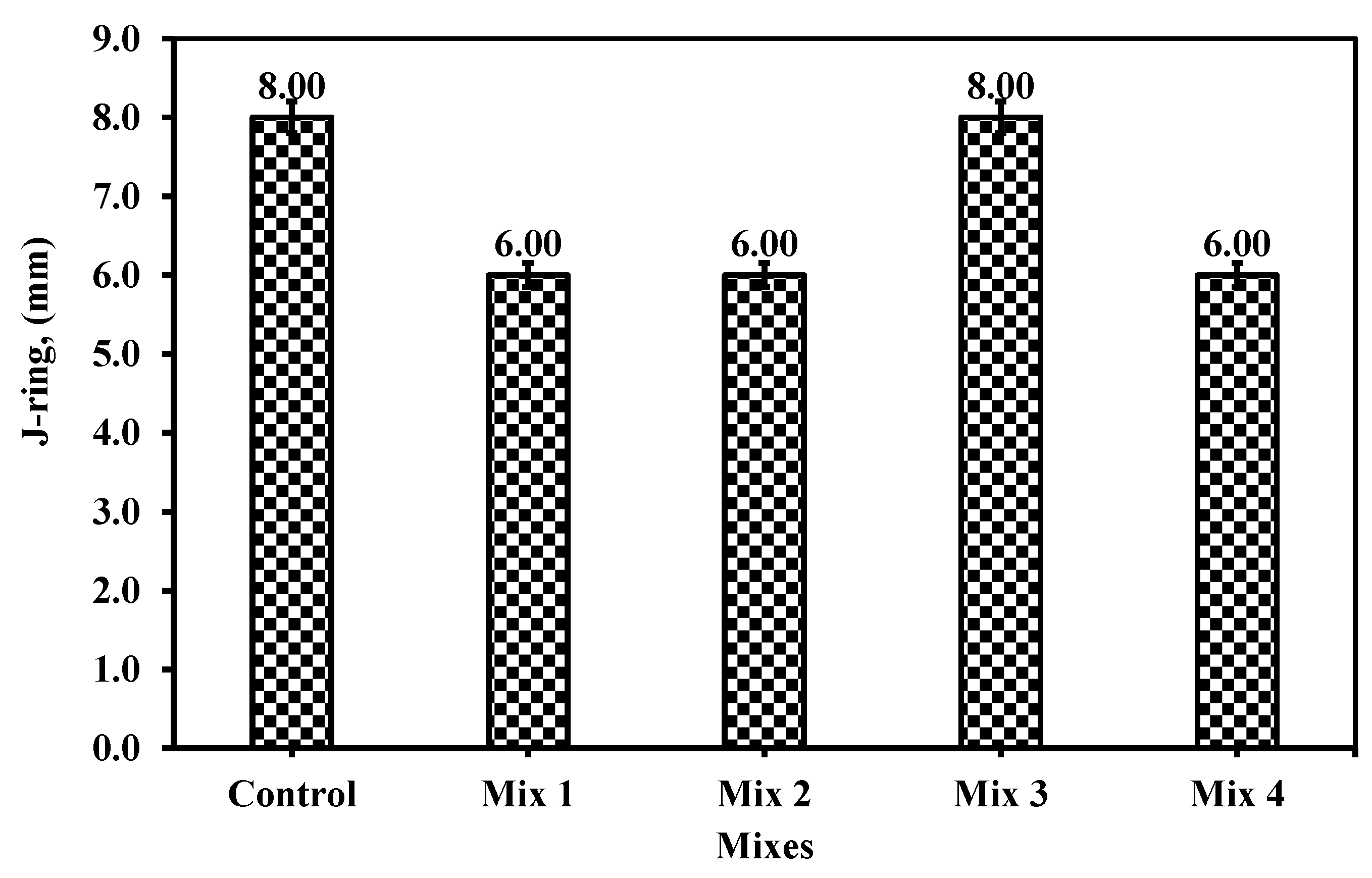

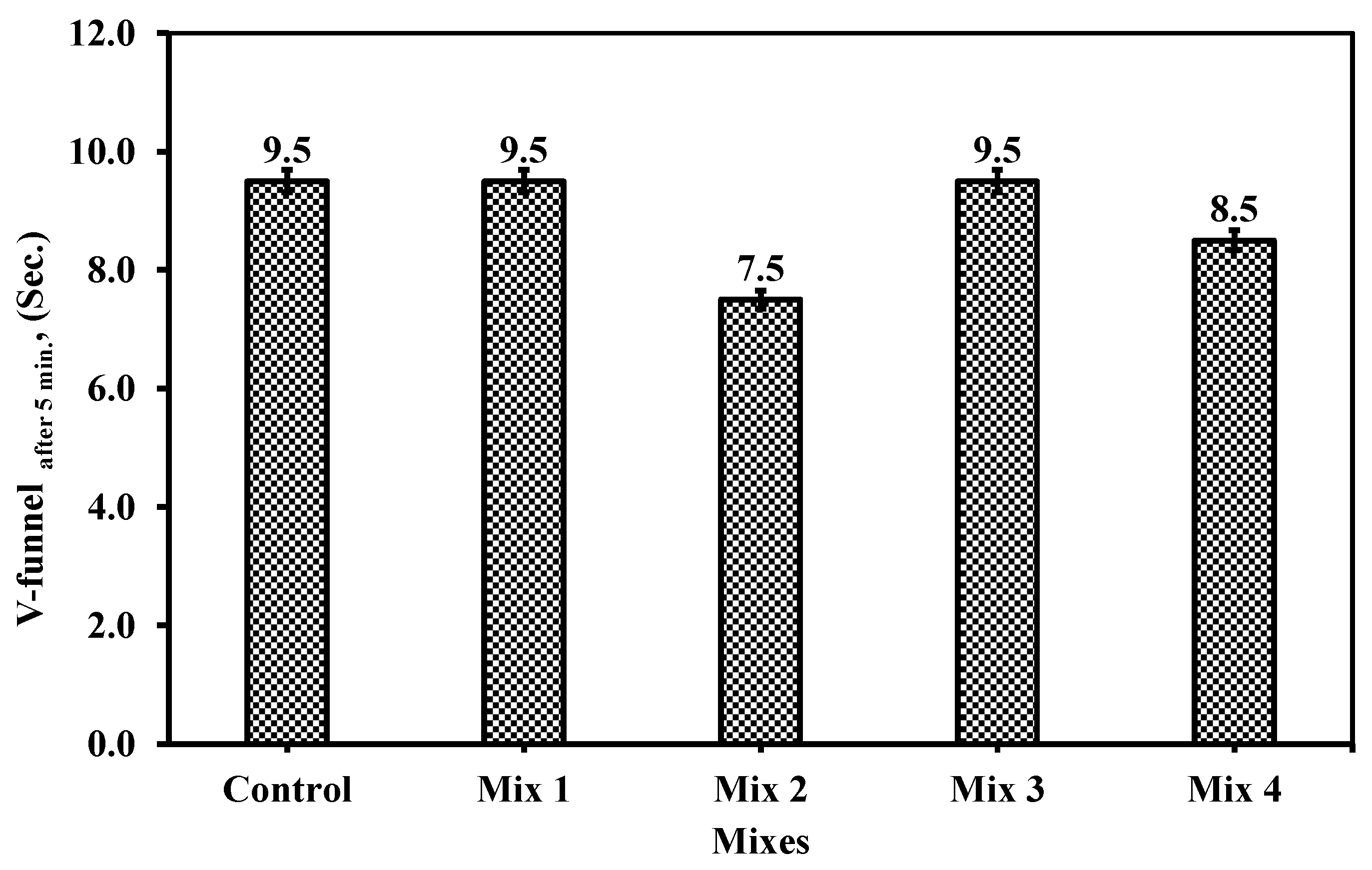

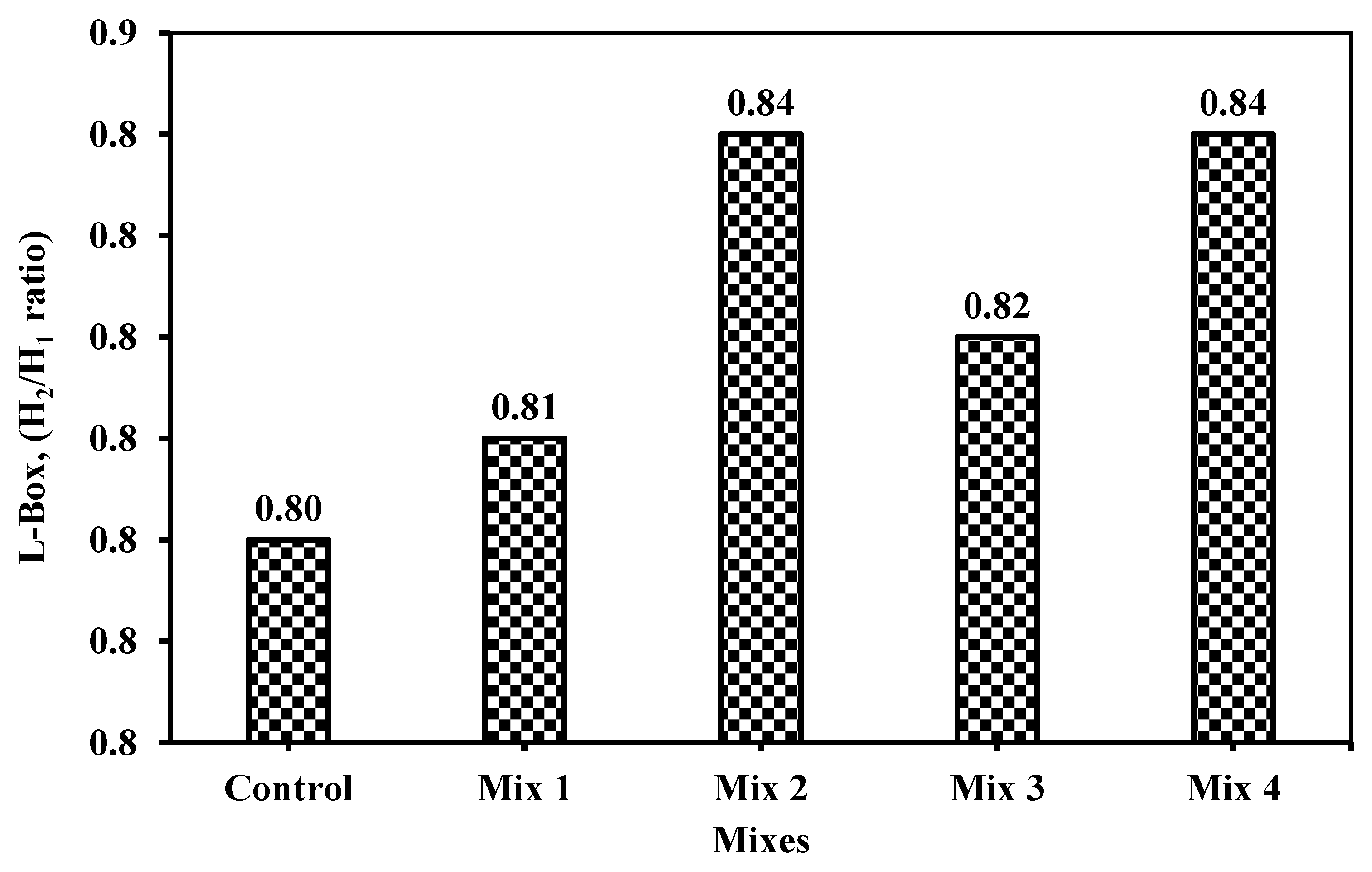

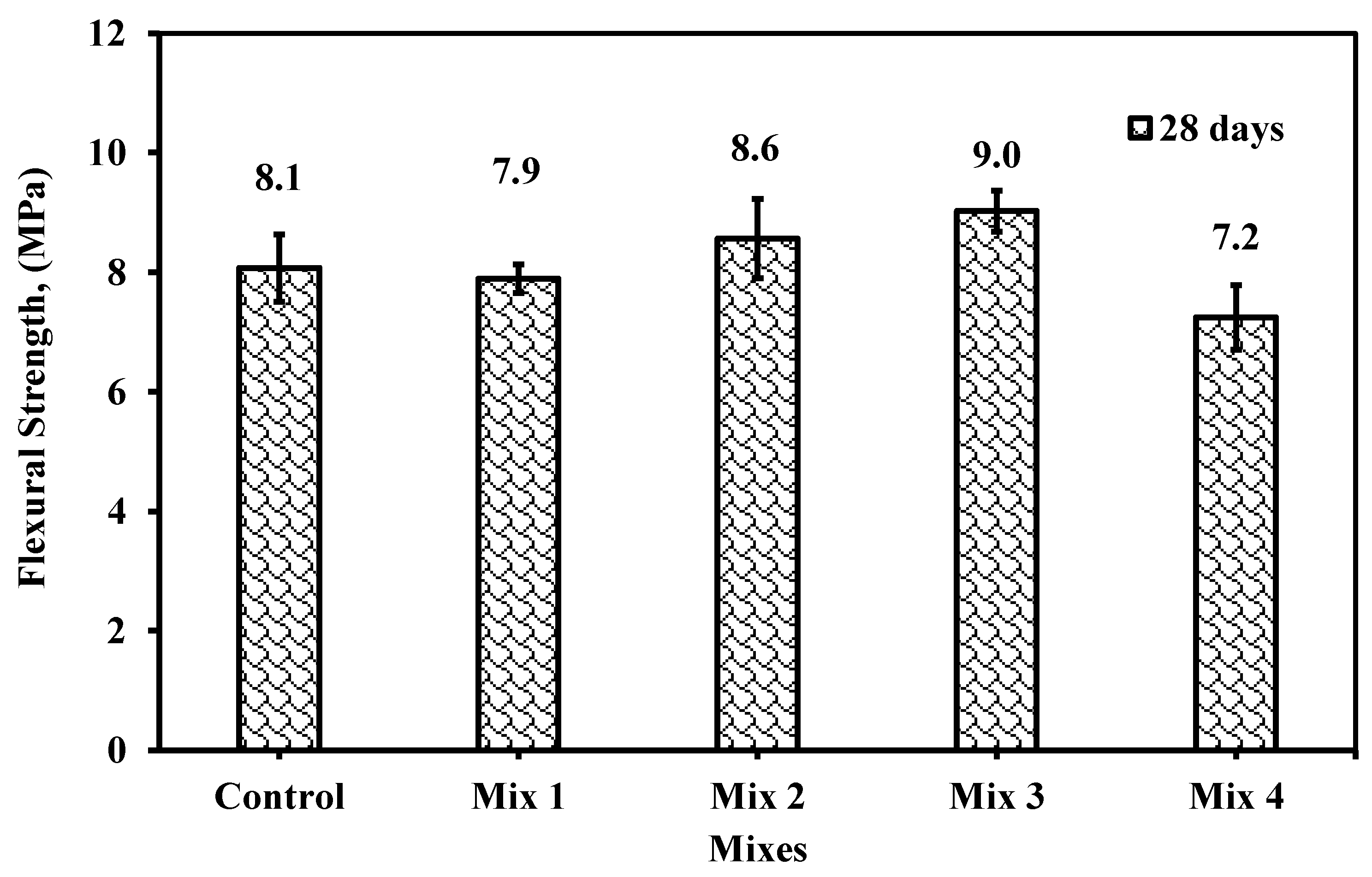
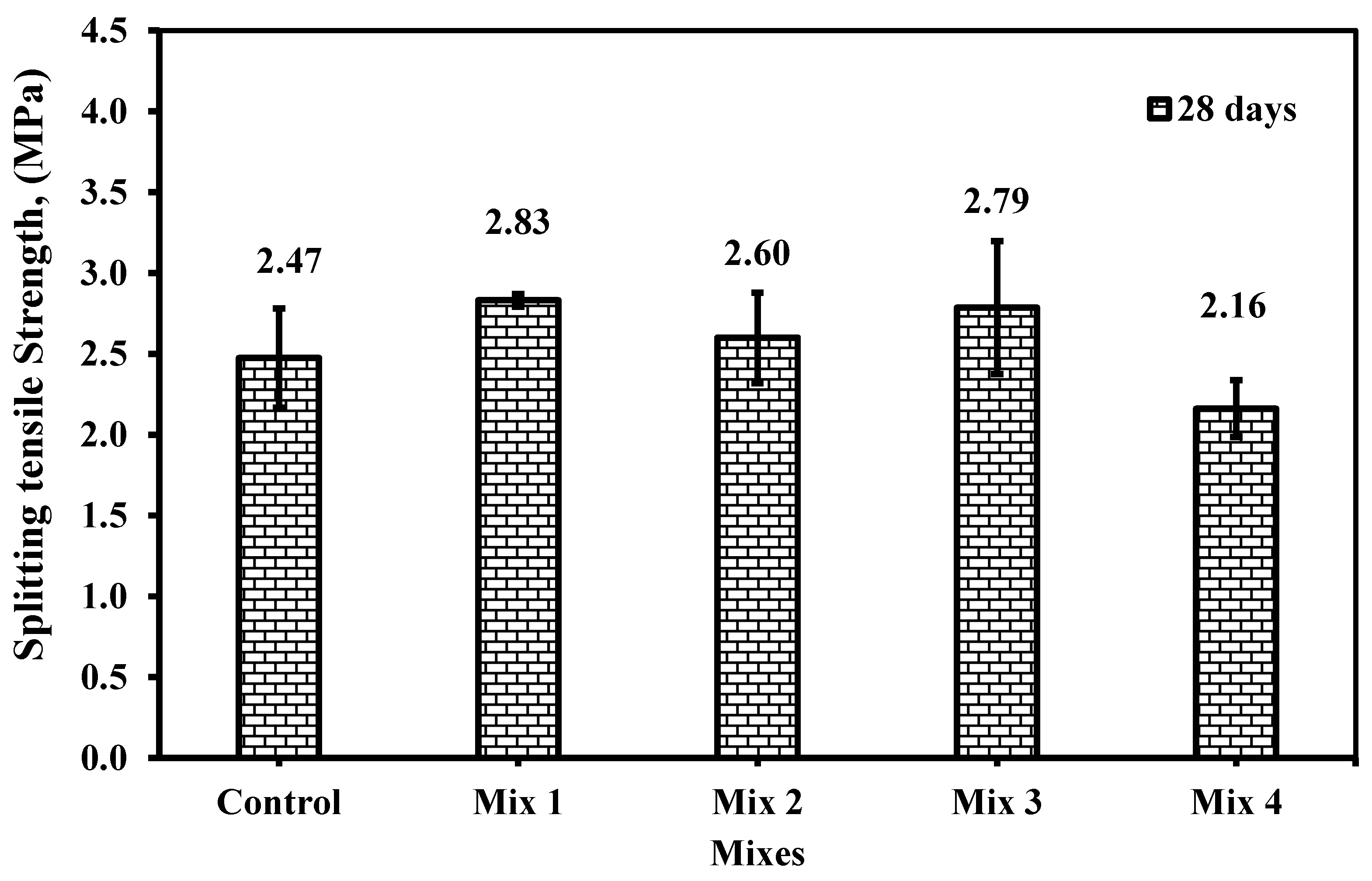
| Mix Code | Designation | Water (kg/m3) | Cement (kg/m3) | CWP (kg/m3) | CA (kg/m3) | FA (kg/m3) | RG (kg/m3) |
|---|---|---|---|---|---|---|---|
| Control | 100% C + 100% FA | 231 | 550 | - | 612 | 909 | 0 |
| Mix 1 | 20% CWP + 5% RG | 231 | 440 | 110 | 612 | 863.55 | 45.45 |
| Mix 2 | 20% CWP + 15% RG | 231 | 440 | 110 | 612 | 772.65 | 136.35 |
| Mix 3 | 15% CWP + 10% RG | 231 | 467.5 | 82.5 | 612 | 818.1 | 90.9 |
| Mix 4 | 25% CWP + 10% RG | 231 | 412.5 | 137.5 | 306 | 818.1 | 90.9 |
| Materials | Cement | Ceramic Powder (CWP) | Glass (RG) |
|---|---|---|---|
| SiO2 | 25.3 | 63.9 | 81.98 |
| Al2O3 | 6.64 | 18.29 | 0.86 |
| Fe2O3 | 6.68 | 4.32 | 0.23 |
| CaO | 58.44 | 4.46 | 10.67 |
| MgO | 2.29 | 0.72 | 5.63 |
| P2O5 | 0 | 0.16 | 0.12 |
| K2O | 0.25 | 2.18 | 0.23 |
| Na2O | 0.66 | 0.75 | - |
| SO3 | 2.04 | 0.1 | 0.19 |
| Cl | 0.06 | 0.005 | - |
| TiO2 | - | 0.61 | - |
| SrO2 | - | 0.02 | - |
| Mn2O3 | - | 0.05 | - |
| LOI | 4 | 1.61 | - |
| The Rheological Test | Units | Limits | |
|---|---|---|---|
| Min. | Max. | ||
| Slump Flow (diameter) | mm | 600 | 800 |
| Time for reaching slump flow with a diameter of 500 mm (T50 cm) | sec | 2 | 5 |
| J-ring slump flow (diameter) | mm | 0 | 20 |
| V-funnel after immediate mixing (to) | sec | 6 | 12 |
| V-funnel after 5 min from mixing (t5 min.) | sec | to | to + 3 |
| L-box (H2/H1) | ratio | 0.80 | 1.0 |
Disclaimer/Publisher’s Note: The statements, opinions and data contained in all publications are solely those of the individual author(s) and contributor(s) and not of MDPI and/or the editor(s). MDPI and/or the editor(s) disclaim responsibility for any injury to people or property resulting from any ideas, methods, instructions or products referred to in the content. |
© 2025 by the authors. Licensee MDPI, Basel, Switzerland. This article is an open access article distributed under the terms and conditions of the Creative Commons Attribution (CC BY) license (https://creativecommons.org/licenses/by/4.0/).
Share and Cite
ElNemr, A.; Shaltout, R. Rheological and Mechanical Characterization of Self-Compacting Concrete Using Recycled Aggregate. Materials 2025, 18, 1519. https://doi.org/10.3390/ma18071519
ElNemr A, Shaltout R. Rheological and Mechanical Characterization of Self-Compacting Concrete Using Recycled Aggregate. Materials. 2025; 18(7):1519. https://doi.org/10.3390/ma18071519
Chicago/Turabian StyleElNemr, Amr, and Ramy Shaltout. 2025. "Rheological and Mechanical Characterization of Self-Compacting Concrete Using Recycled Aggregate" Materials 18, no. 7: 1519. https://doi.org/10.3390/ma18071519
APA StyleElNemr, A., & Shaltout, R. (2025). Rheological and Mechanical Characterization of Self-Compacting Concrete Using Recycled Aggregate. Materials, 18(7), 1519. https://doi.org/10.3390/ma18071519







